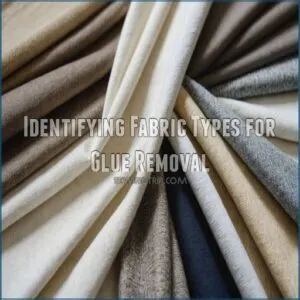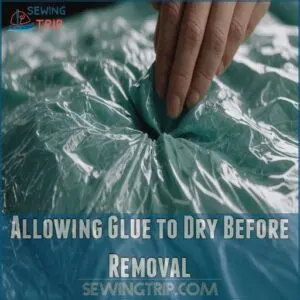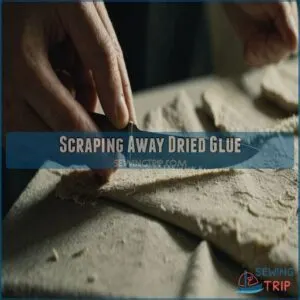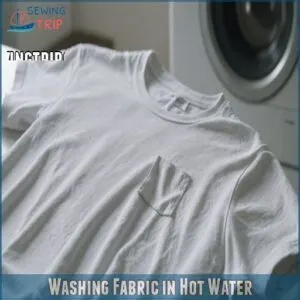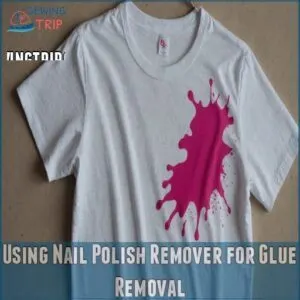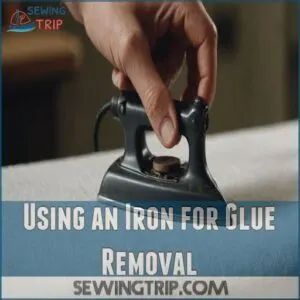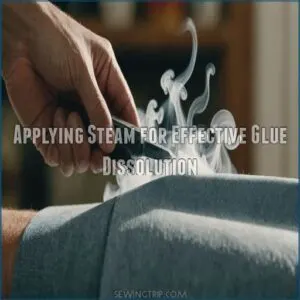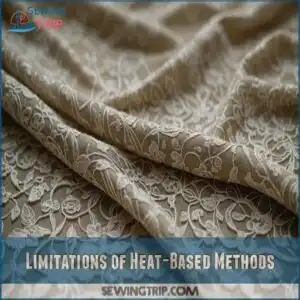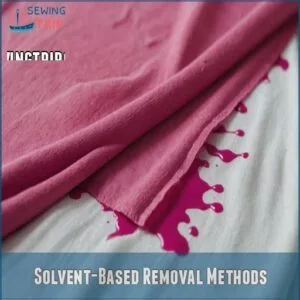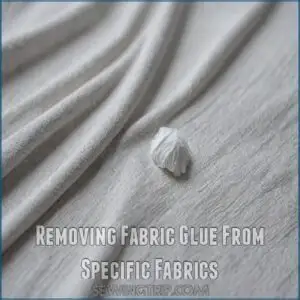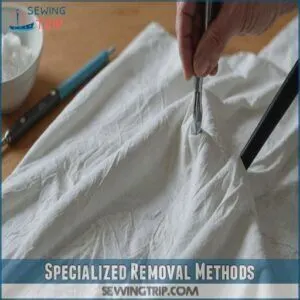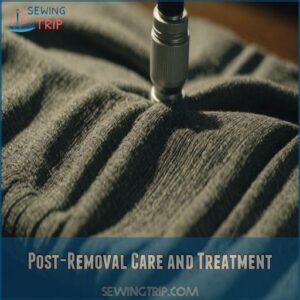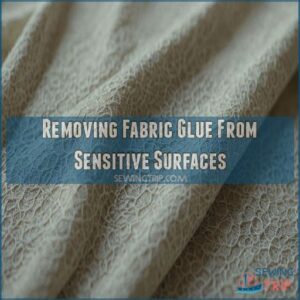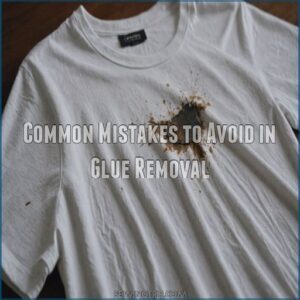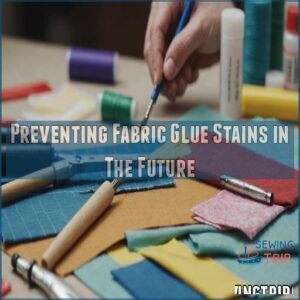This site is supported by our readers. We may earn a commission, at no cost to you, if you purchase through links.
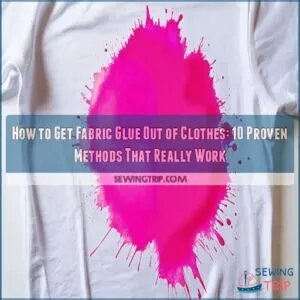
First, try freezing the garment and then gently scrape off the hardened glue with a butter knife.
If you’re feeling adventurous, dab a bit of nail polish remover on the spot, but be careful with delicate fabrics.
Baking soda mixed with coconut oil can also be your secret weapon.
For a warm approach, soak the fabric in hot, soapy water, then scrub away.
Each method has its quirks, so pick your favorite and say goodbye to glue-clogged clothes.
Curious about what works best for your fabric type?
Table Of Contents
- Key Takeaways
- Identifying Fabric Types for Glue Removal
- General Removal Techniques
- Heat-Based Removal Methods
- Solvent-Based Removal Methods
- Removing Fabric Glue From Specific Fabrics
- Specialized Removal Methods
- Post-Removal Care and Treatment
- Removing Fabric Glue From Sensitive Surfaces
- Common Mistakes to Avoid in Glue Removal
- Preventing Fabric Glue Stains in The Future
- Frequently Asked Questions (FAQs)
- Conclusion
Key Takeaways
- Let glue dry completely before trying to remove it; this makes it easier to scrape off without spreading.
- Choose removal methods based on fabric type; heat might work for polyester, while delicate fabrics like chiffon need gentler approaches.
- Use household items like nail polish remover or vinegar to soften and dissolve glue, but always test on a hidden area first.
- Pre-treat fabrics and follow manufacturer instructions to prevent future glue mishaps and ensure effective removal.
Identifying Fabric Types for Glue Removal
Knowing your fabric type is essential for effective glue removal since each material reacts differently to various methods.
Don’t worry—once you identify the fabric, you’ll have a clearer path to saying goodbye to those stubborn glue spots.
Understanding Fabric Types and Glue Interactions
When tackling fabric glue, understanding fabric types is key.
Each fabric—be it polyester or delicate chiffon—interacts differently with glue.
Consider the fabric’s heat tolerance and solvent compatibility before choosing your removal method.
Knowing how the fabric and stain resistance interact with glue types helps you pick the right approach, protecting your clothes while efficiently removing stubborn spots.
Common Fabrics and Suitable Removal Methods
Knowing which fabric you’re dealing with can make a difference.
Polyester, a common completely synthetic fiber type, responds well to boiling water or a freeze-then-scrape method.
Denim likes detergent but stubborn glue may need nail polish remover.
Nylon prefers isopropyl alcohol, while cotton benefits from a pressing method.
Chiffon is delicate, so consider steam or a gentle stain remover for best results.
General Removal Techniques
Tackling fabric glue stains might seem intimidating, but starting with basic removal techniques makes it manageable.
Make sure the glue is completely dry before using a dull tool to scrape it off.
Try washing in hot water if the fabric allows.
Allowing Glue to Dry Before Removal
Before tackling that stubborn glue, let it dry completely.
This simple step is essential for glue removal success.
Why? Because:
- Dried glue is much easier to remove.
- You’ll avoid spreading the glue further.
- It prevents unnecessary fabric damage.
Patience pays off! Giving the glue ample drying time saves you time and frustration in the long run.
Scraping Away Dried Glue
Now that you’ve let the glue dry, it’s time to scrape it away.
Use a dull metal or plastic knife carefully to avoid fabric damage while removing dried glue.
Here’s a quick guide:
| Scraping Tools | Tips |
|---|---|
| Plastic Knife | Flexible and safe |
| Metal Spoon | Gentle scraping |
| Credit Card | Sturdy edge |
| Butter Knife | Wider surface |
| Tweezers | Precision work |
Washing Fabric in Hot Water
Jumping from scraping dried glue, let’s talk washing fabric in hot water. It’s a simple yet effective trick: 1. Check the fabric’s safety for high temps—twisting the wrong knob on your washing machine settings can backfire.
2. Use the hottest water temperature safe for the fabric.
3. Focus on stain removal while keeping the drying techniques handy.
Using Nail Polish Remover for Glue Removal
Hot water not cutting it? Grab some nail polish remover—acetone is your new pal in this fabric fix.
Gently dab a bit on a cloth, and work it into the glue stain.
Remember, some fabrics demand a little respect, so test a small spot first.
If that glue budges, you’ve got an effective solvent on hand!
Heat-Based Removal Methods
When fabric glue refuses to budge, using heat can be a practical solution. You can try applying an iron or steam to loosen the glue, making it easier to remove.
Using an Iron for Glue Removal
Scraping dried glue might work, but using an iron can give better results.
Here’s how:
- Check Iron Settings: Make sure the ironing temperature is safe for your fabric.
- Cover It Up: Use a cloth between the iron and glue.
- Press Gently: Move the iron smoothly.
- Monitor Progress: Repeat until glue loosens safely.
Applying Steam for Effective Glue Dissolution
Using steam works wonders for dissolving fabric glue without damaging your clothes.
Just set your steam iron to a safe level and hold it a few inches above the glue spot.
The steam helps melt the glue, making it easy to blot out.
Remember, not every glue type fares well with steam, so check if this method suits your fabric beforehand.
Limitations of Heat-Based Methods
While steam can work wonders, it’s not a magic bullet.
Remember, heat can damage certain fabric types.
Before you reach for the iron, consider these limitations:
- Heat sensitivity varies greatly depending on the fabric type.
- Some glues are resistant to heat, making this method ineffective.
- Excessive heat might cause color fading or even damage your clothes. Always test a hidden area first!
Solvent-Based Removal Methods
Solvent-based methods can help you tackle stubborn fabric glue stains with ease.
From nail polish remover to various adhesive solvents, these solutions offer practical ways to restore your clothes.
So try them with confidence.
Using Fabric Softener for Glue Removal
Feeling stuck with glue stains? Try a simple trick using fabric softener.
Mix equal parts fabric softener and hot water in a spray bottle and spritz on the stain.
For tougher glue stains, you can also use an iron on its lowest temperature setting.
While allowing it to soak for 15 minutes, consider your glue’s mood.
| Fabric Softener Types | Effectiveness | Safety Considerations |
|---|---|---|
| Liquid | High | Use gloves |
| Sheets | Moderate | Avoid skin contact |
| Organic | Variable | Test on fabric |
Rinse thoroughly, and repeat if needed!
Applying Nail Polish Remover
Got fabric glue stuck on your clothes? Nail polish remover can be a lifesaver.
Gently dab it on the glue spot, using a cotton ball or swab.
Safety tip: test a hidden area first to avoid fabric damage.
It’s effective but remember—some fabrics like acetate won’t play nice.
For other cases, explore alternative methods for those pesky glue spots.
Using Other Solvents and Adhesive Removers
Tried nail polish remover and still got glue troubles?
You might need to explore other removers.
Solvent safety is key here, so grab some isopropyl alcohol or even white vinegar.
Saturate the glued area, let it sit, then gently rub it off.
DIY solutions can save you, but watch for common mistakes like fabric discoloration.
Removing Fabric Glue From Specific Fabrics
Fabric glue stains, depending on the material you’re working with, require different approaches.
Whether it’s polyester, denim, nylon, or cotton, knowing how to tackle each fabric type ensures you’ll get the best possible results without causing damage.
Removing Glue From Polyester and Denim
Moving from solvent methods, let’s tackle polyester and denim with these glue removal tricks.
For polyester, try boiling water to lift the glue.
If you’re looking for a more targeted approach, you can find a range of glue removal products designed specifically for polyester fabrics.
If denim’s your fabric, a gentle nail polish remover works wonders.
These polyester glue removal tips and denim glue removal solutions can save your day and keep your clothes looking fresh and free from those pesky stains.
Removing Glue From Nylon and Cotton
Tackling nylon and cotton glue mishaps?
For nylon, isopropyl alcohol or even nail polish remover might do the trick, considering nylon’s durability and elasticity, as seen in its comparison to natural fibers.
Cotton’s more forgiving; blot the glue, cover with paper towels, and carefully iron it.
Remember, the glue type impacts your approach.
DIY solutions often work, but stubborn stains might need professional cleaning.
Always test a hidden area first!
Removing Glue From Chiffon and Wool
Struggling with glue on delicate chiffon or wool?
You can try a super glue remover specifically designed for fragile fabrics to save the day.
If steam’s your thing, it might gently coax the glue off without causing fabric damage.
Always test on an unseen area first.
This approach keeps your favorite pieces safe from permanent mishaps and stains.
Specialized Removal Methods
When you’ve got glue that’s more than just your usual sticky situation, specialized techniques can save the day.
Learn how to tackle tougher adhesives like glitter, epoxy, and super glue to keep your clothes looking their best.
Removing Glitter Glue From Fabric
Glitter glue removal can feel like catching a slippery fish; it’s tricky but doable.
Start by freezing the fabric to harden the glue, making it easier to scrape off without fabric damage.
If the glitter glue is of a permanent type, consider using heat methods or a vinegar solution method as an alternative removal approach.
Consider DIY solutions like rubbing isopropyl alcohol gently on the glue.
Always think about safety precautions, and test alternative methods on a hidden area first.
Removing Epoxy and Super Glue
To remove epoxy or super glue, quick action is key.
Epoxy removal tips include warming the fabric with an iron on low heat.
For super glue dangers, a few drops of acetone can lift stubborn spots, or using a commercial super glue remover.
Just be cautious—always test first.
Keep these in mind:
- Test on a small area
- Avoid scrubbing vigorously
- Rinse thoroughly afterward
Removing Elmer’s Glue and Eyelash Glue
Got a sticky situation with Elmer’s or eyelash glue on your clothes?
You’re not alone.
For Elmer’s, soak the fabric in cold water, letting it loosen the glue.
Gently scrape it off with a spoon.
Eyelash glue can be trickier; try dabbing with makeup remover and washing afterward.
Remember, prevent future mishaps by exploring crafting alternatives!
Post-Removal Care and Treatment
Once you’ve successfully removed the glue, it’s important to wash and dry the fabric properly to prevent any remaining residue.
You might also consider using stain removers and finishing with ironing or steaming to make sure your garment looks its best again.
Washing and Drying Fabric After Glue Removal
After tackling that stubborn glue, it’s time for laundry.
Consider using a gentle cycle detergent specifically designed for delicate or special-care items gentle cycle formulas.
Check your garment’s care label; fabric washing temperatures vary.
Wash the item as directed, using a gentle cycle if possible.
Air drying is often best to prevent shrinkage, but a low tumble dryer setting works too.
Remember, always follow the fabric recommendations on the label to keep your clothes looking their best.
Applying Stain Removers for Residual Glue
You’ve washed your fabric, but a little glue remains.
Don’t sweat it; stain removers come to the rescue.
Here’s how:
- Pick a stain remover suitable for your fabric.
- Apply it over the glue residue.
- Wait for the recommended duration.
- Rinse thoroughly.
Simple steps transform stubborn spots, leaving your clothes looking good as new.
Ironing and Steaming Fabric for Finishing
Give your clothes a final refresh with smart ironing techniques.
Use gentle steam settings for fabric types like cotton or polyesters.
Iron from the inside to avoid heat damage.
Make finishing touches as smooth as a skater on fresh ice.
You’ll love how it feels when everything sits just right.
| Fabric Type | Iron Setting | Notes |
|---|---|---|
| Cotton | Medium-High | Use steam |
| Polyester | Medium | Avoid overheat |
| Silk | Low | No steam |
| Wool | Medium | Use a cloth |
Removing Fabric Glue From Sensitive Surfaces
When dealing with fabric glue on sensitive surfaces like skin, plastic, or leather, you’ll need patience and the right approach to remove it effectively.
Use gentle techniques with common household items to avoid damage and keep these surfaces looking their best.
Removing Glue From Skin and Hair
You’re in a sticky situation with glue on your skin or hair? Relax! Here are some safe removal methods:
- Soak: Dip your skin or hair in warm, soapy water.
- Lemon Juice: Rub a lemon halve on the area for added effectiveness.
- Oil: Use olive oil to loosen the glue.
- Patience: Let it rest and gently peel.
These glue removal tips should help without skin irritation!
Removing Glue From Plastic and Wood
Tackling glue on wood or plastic? Use your savvy to navigate this sticky situation.
Grab a credit card or a similar tool to gently scrape off excess glue.
For stubborn glue, soak a cloth in alcohol or vinegar and press it onto the affected area.
Remember, patience and the right DIY solutions make all the difference.
Removing Glue From Leather and Glass
Removing glue from leather and glass needs care.
For leather, follow these steps:
- Dab nail polish remover on a cotton swab and apply gently.
- Blot with a dry cloth to lift the glue.
- Wipe with warm water for cleaning leather surfaces.
For glass, scrape off gently with a plastic tool. Glue stain prevention is key.
Common Mistakes to Avoid in Glue Removal
Before you start scrubbing, let’s look at some common glue-removal mistakes to avoid. Knowing these pitfalls will save you time and potentially prevent further damage to your favorite clothes.
Using Excessive Heat or Solvents
When removing fabric glue, it’s easy to overdo it with heat or solvents, risking fabric damage.
Applying too much heat can scorch or melt delicate materials, while harsh solvents might fade or weaken fibers.
Instead, consider safe alternatives, such as choosing methods suited to the glue type and fabric.
Be gentle and test solutions on inconspicuous areas first.
Applying Sharps Objects for Glue Removal
You’ve tried everything, but reaching for sharp objects can lead to disaster. They’re a one-way ticket to torn clothes, while safe scraping methods keep fabric intact. Imagine your favorite sweater with a hole—it’s enough to make anyone cringe.
- Opt for plastic knives to avoid mishaps
- Try wooden sticks for gentle scraping
- Use old credit cards instead of blades
- Keep dull knives on hand for fabric safety
- Avoid anything sharp near delicate materials
Ignoring Fabric Type and Composition
It’s tempting to grab any method and start scrubbing, but ignoring fabric type and composition is a quick ticket to ruined clothes.
Universal Glue Removal isn’t a one-size-fits-all.
DIY Glue Removal needs consideration for Fabric Damage Risk.
With different Common Glue Types, choose Safe Removal Methods matched to your fabric’s needs, and watch the glue dissolve without drama.
Preventing Fabric Glue Stains in The Future
To keep fabric glue from sticking where it shouldn’t, try using alternative adhesives or fasteners.
Always pre-treat your fabric before applying glue.
Follow the manufacturer’s instructions carefully to make sure you have a mess-free crafting experience.
Using Alternative Adhesives and Fasteners
Stepping away from the typical glue hassles, consider using alternative methods.
Fabric adhesives aren’t your only option when you need a fix.
Think about these choices:
You can explore various types of sewing fasteners.
Removable fasteners let you switch things up on a whim.
Sewing techniques offer a classic, strong hold.
Heat-activated adhesives bond securely without mess.
Pressure-sensitive adhesives stick nicely but release on demand.
Velcro strips are a trusty, adjustable friend.
Pre-Treating Fabric Before Glue Application
Before getting crafty with fabric glue, think ahead with pre-treating fabric.
It’s like giving your clothes a protective shield against future stains.
A basic fabric protector spray keeps pesky glue from sticking like an unwanted guest.
It’s quick, easy, and gives your garments a fighting chance.
Make your next DIY project a breeze with this fabric safety tip!
Following Manufacturer Instructions for Glue Use
Always check the glue type’s instructions before starting.
Knowing the drying time helps you plan your project.
Safety precautions are very important; always work in a well-ventilated area.
Application tips often include using a small amount of glue.
Cleaning guidelines vary depending on the glue, so read carefully!
Following these steps helps prevent those frustrating glue mishaps.
Frequently Asked Questions (FAQs)
How to remove glue from fabric?
About 3 billion pounds of glue are sold each year, so you’re not alone in dealing with spills.
To remove glue from fabric, try a mix of heat, fabric softener, or nail polish remover.
Can you use vinegar to remove fabric glue from clothes?
You can try vinegar to remove fabric glue by soaking a cloth in vinegar and dabbing the glue spot.
The acidity helps dissolve glue particles.
Rinse thoroughly afterward.
It’s a gentle approach worth a shot!
How to remove glue stains from clothes?
Removing glue stains can be like untangling stubborn vines.
First, let the glue dry, then scrape gently.
Apply nail polish remover or hot water, depending on fabric type.
Wash thoroughly afterward.
Act promptly for best results!
How do you remove rubber glue from clothes?
To remove rubber glue from clothes, let it dry completely.
Then carefully scrape it off with a dull knife.
If needed, apply nail polish remover to dissolve remaining glue, and wash the area thoroughly with cold water.
How do you get dried fabric glue out of clothes?
Imagine this: that stubborn glue, defeated! Scrape away dried glue gently. Then, soak the fabric in hot water or try nail polish remover. Finally, wash as usual. Problem solved!
Does fabric glue wash out?
Fabric glue doesn’t typically wash out easily.
It’s designed for a strong bond, so you’ll usually need specific methods, like applying heat or using nail polish remover, to remove it from clothing.
Regular washing isn’t enough.
Can vinegar remove glue from clothes?
Vinegar might help loosen glue from clothes, but don’t expect miracles.
Soak the spot with vinegar, let it sit briefly, and gently scrape.
Repeat if needed, as vinegar works best on smaller glue stains.
How do you dissolve hardened glue?
To dissolve hardened glue, gently heat it using a hairdryer or iron on low heat.
Use nail polish remover or rubbing alcohol for extra stubborn spots.
Make sure you have proper ventilation and test on a small area first.
Is it safe to use vinegar on fabric?
Using vinegar on fabric is generally safe, but test it on a small, hidden area first.
Vinegar can act as a gentle cleaner but may fade colors.
It’s a classic trick that often works wonders.
How long does glue removal typically take?
Getting fabric glue off clothes can feel like a marathon when you’re anxious to see results.
Depending on the method and glue type, it typically takes anywhere from a few minutes to a couple of hours.
Can fabric glue cause permanent stains?
Fabric glue can make stains that seem stubborn, but they aren’t always permanent.
Quick action is key—try using heat or a solvent like nail polish remover.
Fabric type can influence how effectively you can remove the stain.
Whats the best way to soften dried glue?
Remember that time you spilled glue? Don’t panic!
Soak the glued area in warm, soapy water.
Then, gently scrape away softened glue with a dull knife.
A hairdryer‘s heat can also help loosen it.
Are there eco-friendly glue removal options?
Try using white vinegar or lemon juice for an eco-friendly approach to remove glue from clothes.
Soak the affected area, let it sit for a few minutes, and gently scrub with a brush before washing.
Conclusion
Isn’t it a relief to know that getting fabric glue out of clothes isn’t as challenging as it seems?
With these ten proven methods, you can tackle even the toughest glue stains.
Whether you freeze, scrape, or soak, there’s a technique for every fabric type.
Just remember, patience and the right approach make all the difference.
So next time you’re faced with a glue mishap, you’ll know exactly how to handle it with ease.

